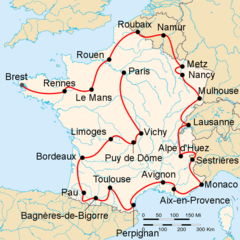Tour de France 1952
| |||
 Trasa Tour de France 1952 | |||
| Data | 25 czerwca - 19 lipca 1952 | ||
|---|---|---|---|
| Etapów | 23 | ||
| Dystans | 4807 km | ||
| Czas zwycięzcy | 151h 57' 20" (31,739 km/h) | ||
| Zgłoszenia | 122 kolarzy | ||
| Ukończyło wyścig | 78 kolarzy | ||
| Podium | |||
| Pierwsze miejsce | |||
| Drugie miejsce | |||
| Trzecie miejsce | |||
| Pozostałe klasyfikacje | |||
| Górska | |||
| Drużynowa | |||
39. Tour de France rozpoczął się 25 czerwca w Brest, a zakończył 19 lipca 1952 roku w Paryżu. W klasyfikacji generalnej zwyciężył po raz drugi Włoch Fausto Coppi (poprzednio w 1949 roku). Coppi był także najlepszy w klasyfikacji górskiej, a w klasyfikacji drużynowej zwyciężyła reprezentacja Włoch.
Drużyny
- Szwajcaria
- Belgia
- Włochy
- Francja
- Holandia
- Hiszpania
- Luksemburg
- Paris
- Nord-Est/Centre
- Sud-Est
- Ouest/Sud-Ouest
- Afryka Północna
Etapy
| Etap | Data | Trasa | Dystans | Zwycięzca | Lider wyścigu |
|---|---|---|---|---|---|
| 1 | 25 czerwca | Brest – Rennes | |||
| 2 | 26 czerwca | Rennes – Le Mans | |||
| 3 | 27 czerwca | Le Mans – Rouen | |||
| 4 | 28 czerwca | Rouen – Roubaix | |||
| 5 | 29 czerwca | Roubaix – | |||
| 6 | 30 czerwca | ||||
| 7 | 1 lipca | Metz – Nancy | |||
| 8 | 2 lipca | Nancy – Miluza | |||
| 9 | 3 lipca | Miluza – | |||
| 10 | 4 lipca | ||||
| 11 | 6 lipca | Le Bourg-d’Oisans – | |||
| 12 | 7 lipca | ||||
| 13 | 8 lipca | ||||
| 14 | 9 lipca | Aix-en-Provence – Awinion | |||
| 15 | 10 lipca | Awinion – Perpignan | |||
| 16 | 11 lipca | Perpignan – Tuluza | |||
| 17 | 13 lipca | Tuluza – Bagnères-de-Bigorre | |||
| 18 | 14 lipca | Bagnères-de-Bigorre – Pau | |||
| 19 | 15 lipca | Pau – Bordeaux | |||
| 20 | 16 lipca | Bordeaux – Limoges | |||
| 21 | 17 lipca | Limoges – Puy de Dôme | |||
| 22 | 18 lipca | Clermont-Ferrand – Vichy | |||
| 23 | 19 lipca | Vichy – Paryż |
Liderzy klasyfikacji po etapach
| Etap | Zwycięzca | Klasyfikacja generalna | Klasyfikacja górska | Klasyfikacja drużynowa |
|---|---|---|---|---|
| 1 | Rik Van Steenbergen | Rik Van Steenbergen | brak | Belgia |
| 2 | André Rosseel | |||
| 3 | Nello Lauredi | Nello Lauredi | Francja | |
| 4 | Pierre Molinéris | |||
| 5 | Jean Diederich | |||
| 6 | Fiorenzo Magni | Fiorenzo Magni | ||
| 7 | Fausto Coppi | Nello Lauredi | ||
| 8 | Raphaël Géminiani | Fiorenzo Magni | Raphaël Géminiani | |
| 9 | Walter Diggelmann | Andrea Carrea | ||
| 10 | Fausto Coppi | Fausto Coppi | Antonio Gelabert | |
| 11 | Fausto Coppi | Fausto Coppi | ||
| 12 | Jan Nolten | |||
| 13 | Raoul Rémy | |||
| 14 | Jean Robic | |||
| 15 | Georges Decaux | Włochy | ||
| 16 | André Rosseel | |||
| 17 | Raphaël Géminiani | |||
| 18 | Fausto Coppi | |||
| 19 | Hans Dekkers | |||
| 20 | Jacques Vivier | |||
| 21 | Fausto Coppi | |||
| 22 | Fiorenzo Magni | |||
| 23 | Antonin Rolland | |||
| Klasyfikacja końcowa | Fausto Coppi | Fausto Coppi | Włochy | |
Klasyfikacje
Klasyfikacja generalna
| Klasyfikacja górska
|
Drużynowa
| Poz. | Kraj | Czas |
|---|---|---|
| 1. | 455h 56' 40" | |
| 2. | +25' 16" | |
| 3. | +54' 56" | |
| 4. | +2h 53' 44" | |
| 5. | +2h 59' 52" |
Bibliografia
Media użyte na tej stronie
Pictograms of Olympic sports - Cycling (road). This is unofficial sample picture. Images of official Olympic pictograms for 1948 Summer Olympics and all Summer Olympics since 1964 can be found in corresponding Official Reports.
Autor: https://phabricator.wikimedia.org/diffusion/GOJU/browse/master/AUTHORS.txt, Licencja: MIT
An icon from the OOjs UI MediaWiki lib.
Autor: https://phabricator.wikimedia.org/diffusion/GOJU/browse/master/AUTHORS.txt, Licencja: MIT
An icon from the OOjs UI MediaWiki lib.
Autor: SanchoPanzaXXI, Licencja: CC BY-SA 4.0
Flag of Spain during the Spanish State. It was adopted on 11 October 1945 with Reglamento de Banderas Insignias y Distintivos (Flags, Ensigns and Coats of Arms Bill)
Autor: IIVQ - Tijmen Stam, Licencja: CC-BY-SA-3.0
Differenty colored cycling jerseys as used in different cycling contests. In the Tour de France, the members of the leading team wear a number bar with a yellow background.
Autor: Iivq - Tijmen Stam, Licencja: CC-BY-SA-3.0
Differenty colored cycling jerseys as used in different cycling contests
green jersey. Used by:
- Points leader in Tour de France
- Points leader in Vuelta a España
- Mountain leader in Giro d'Italia
- Mountain leader in Tour de Pologne
- Líder Premio Sprinter Vuelta Ciclista del Uruguay
Autor: Iivq - Tijmen Stam, Licencja: CC-BY-SA-3.0
Differenty colored cycling jerseys as used in different cycling contests
white jersey. Used by:
- overall leader of age under 25 in Tour de France
- combination leader in Vuelta a España
- youth leader in Giro d'Italia
- overall leader in Driedaagse van De Panne-Koksijde
Autor:
- File:France_blank.png: User:Sting
- Derivative work: EdgeNavidad
Route of the 1952 Tour de France, starting in Brest and finishing in Paris. The black dots are the cities where a stage ended (and possibly started), the grey dots are the cities with a stage start but no stage finish. Route was run clockwise.
Autor: Iivq - Tijmen Stam, Licencja: CC-BY-SA-3.0
Differenty colored cycling jerseys as used in different cycling contests
polka dot jersey. Used by:
- King of the Mountains leader of the Tour de France
- King of the Mountains leader of the Critérium du Dauphiné
- King of the Mountains leader of the Tour of Britain
Icon for mountain stages in bicyling stage races. Modeled after (but not taken from) http://www.letour.fr/2009/TDF/COURSE/us/le_parcours.html.
Icon for plain stage in cycling stage race. Modeled after (but not taken from) http://www.letour.fr/2009/TDF/COURSE/us/le_parcours.html.
Autor: Iivq - Tijmen Stam, Licencja: CC-BY-SA-3.0
Differenty colored cycling jerseys as used in different cycling contests yellow jersey. Used by:
- Overall leader in Tour de France
- Overall leader in Tour de Suisse
- Youth leader in Eneco Pro Tour
- Overall leader in Tour de Pologne

















